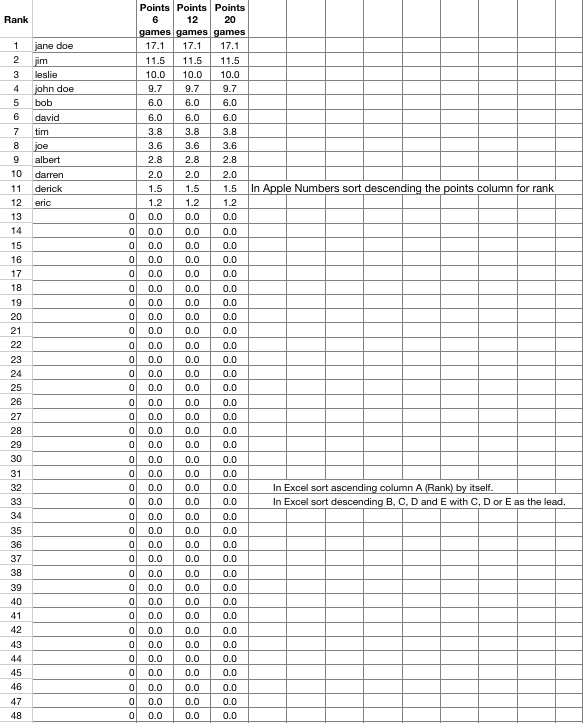Sports Ranking Systems: Explained & Explored | [Your Guide]
Can a number truly capture the essence of competition? Sports rating systems, though complex and ever-evolving, offer a fascinating lens through which we can dissect the competitive landscape, providing insights that shape how we understand and appreciate the games we love.
The realm of sports is a tapestry woven with narratives of triumph, defeat, and unwavering dedication. Within this dynamic environment, the quest to quantify and compare athletic prowess has given rise to sophisticated ranking systems. These systems, often employing intricate mathematical models and data analysis, strive to encapsulate the relative strengths of teams and individuals. The rating percentage index (RPI), for example, is a widely recognized metric, particularly in college sports, used to rank teams based on their wins, losses, and strength of schedule. NCAA basketball, baseball, softball, hockey, soccer, lacrosse, and volleyball all utilize such systems to determine rankings.
The application of ranking systems extends beyond collegiate athletics. The Olympic Games, for instance, employ medal counts to rank participating nations, reflecting their overall success. In the world of chess, the FIDE World Rankings provide a standardized measure of player skill, creating a global hierarchy of strategic brilliance. These diverse examples highlight the universality of ranking systems in providing structure and context to competitive endeavors.
- Diddy Jlos Relationship A Look Back At Their 19992001 Romance
- Find Telugu Movies 2025 Trailers Reviews Where To Watch
The complexity of these systems can vary widely. The chess ranking system, known for its intricacies, contrasts with the relatively simpler approach used in soccer rankings. Each system, however, serves a fundamental purpose: to create a framework for comparison and assessment.
Creating an effective ranking system requires a careful consideration of various factors. For instance, to maintain the integrity of rankings, it's common practice to include recent performances, such as those achieved at the Area Senior Outdoor Championships. This ensures that the rankings remain reflective of current form and competitive levels. The inclusion of recent results is essential for fairness and relevance.
Beyond simply quantifying team performance, rating systems can also provide valuable insights into specific aspects of a game. In the NFL, Elo ratings, for example, can be used to inform point spreads, giving analysts and fans a deeper understanding of potential outcomes. By taking the difference between two teams' Elo ratings and adjusting for factors like home-field advantage, these systems provide a data-driven approach to predicting game results.
- Emilia Clarkes Love Life Rumors Relationships Is She Married
- Kaitlyn Krems Hot Nude Videos Leaks Watch Now
A sports rating system is, at its core, a sophisticated mechanism for analyzing the results of sports competitions. It processes data to generate ratings for each team or player, offering a numerical representation of competitive strength. These ratings, often referred to as power ratings, are designed to be directly comparable, enabling assessments of potential game outcomes.
The evolution of sports rating systems is inextricably linked to advancements in technology and the application of statistical analysis. As the sports world continues to embrace data-driven insights, these systems are constantly refined to ensure they accurately reflect the nuances of competitive play.
The future of sports rating systems is bright, as they are poised to become even more sophisticated and integrated into the fabric of sports analysis and fan engagement. As we move forward, we can expect to see greater use of these systems to objectively fuel competition and offer more informed insights for all those involved.
The success of any ranking system lies in its ability to adapt to the ever-changing landscape of sports. One such system that continues to gain traction is the Elo rating system. With its proven track record and adaptability, the Elo system is an ideal choice for those seeking to rank teams fairly and accurately.
Another widely utilized method for ranking sports teams is the Massey rating system. Similar to the Colley method, it accounts for the significance of each game and the timing within the season. However, the Massey system distinguishes itself by using the point differential of a result, thereby accounting for the winning margin when assigning ratings.
Various ranking methods are at the disposal of sports analysts, and the selection of the best one for a sport depends on the sport's specifics and the goals of the ranking. For sports like baseball, where a large number of games are played, each individual game has a limited impact. In contrast, the NFL places a greater emphasis on each individual game due to its shorter season.
The concept of sports ranking transcends mere data analysis; it forms the bedrock of competitive integrity. The rankings that emerge from these systems contribute to tournament seedings, player evaluations, and even the overall perception of a team's or athlete's skill. A well-designed ranking system can also highlight the strengths and weaknesses of teams and athletes, providing valuable insights that can guide strategic decision-making.
In conclusion, a sports rating system serves as an indispensable tool in the world of sports, bringing order, transparency, and a heightened level of competitiveness. These systems, driven by data, mathematical models, and expert analysis, offer invaluable insights to fans, players, and analysts alike.
Here is a table showcasing the basic components of an Elo rating system:
| Component | Description |
|---|---|
| Player/Team Rating | A numerical value representing the player's or team's skill level. |
| Expected Score | The probability of a player or team winning against another player or team, based on their rating difference. |
| Actual Score | The outcome of the game (e.g., 1 for a win, 0.5 for a draw, 0 for a loss). |
| K-factor | A constant that determines the sensitivity of rating changes after each game. |
| Rating Update | The adjustment to a player's or team's rating after a game, calculated using the K-factor, expected score, and actual score. |
Reference: Elo Rating System - Wikipedia
Considered as a predictor, these systems are at the forefront of sports result forecasting. Computer ratings are now available for almost every sport, from college football and basketball to the NFL, NBA, NHL, MLS, and more. The ability to predict outcomes is something which attracts considerable attention.
- Explore Extreme Gore Videos Uncensored Reality Discover Now
- Beren Saat Biography Facts Career Highlights

Sports Player Ranking System Calculator Office Pool Spreadsheets

Introducing Power Rankings Your Club Ranked Opta Analyst

GSAA Ranking Systems Pre 2018 Girevoy Sport Australia